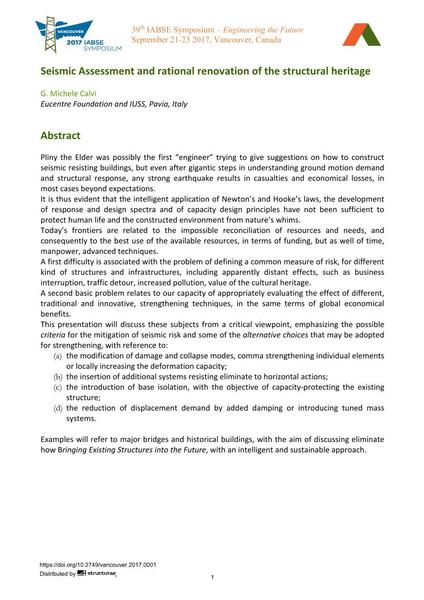Seismic Assessment and rational renovation of the structural heritage

| Author(s): |
G. Michele Calvi
(Eucentre Foundation and IUSS, Pavia, Italy)
|
|---|---|
| Medium: | conference paper |
| Language(s): | English |
| Conference: | IABSE Symposium: Engineering the Future, Vancouver, Canada, 21-23 September 2017 |
| Published in: | IABSE Symposium Vancouver 2017 |
| Page(s): | 1 |
| Year: | 2017 |
| DOI: | 10.2749/vancouver.2017.0001 |
| Abstract: |
Pliny the Elder was possibly the first “engineer” trying to give suggestions on how to construct seismic resisting buildings, but even after gigantic steps in understanding ground motion demand and structural response, any strong earthquake results in casualties and economical losses, in most cases beyond expectations. It is thus evident that the intelligent application of Newton’s and Hooke’s laws, the development of response and design spectra and of capacity design principles have not been sufficient to protect human life and the constructed environment from nature’s whims. Today’s frontiers are related to the impossible reconciliation of resources and needs, and consequently to the best use of the available resources, in terms of funding, but as well of time, manpower, advanced techniques. A first difficulty is associated with the problem of defining a common measure of risk, for different kind of structures and infrastructures, including apparently distant effects, such as business interruption, traffic detour, increased pollution, value of the cultural heritage. A second basic problem relates to our capacity of appropriately evaluating the effect of different, traditional and innovative, strengthening techniques, in the same terms of global economical benefits. This presentation will discuss these subjects from a critical viewpoint, emphasizing the possiblecriteriafor the mitigation of seismic risk and some of thealternative choicesthat may be adopted for strengthening, with reference to:
Examples will refer to major bridges and historical buildings, with the aim of discussing eliminate how Bringing Existing Structures into the Future, with an intelligent and sustainable approach. |
0.19 MB
- About this
data sheet - Reference-ID
10298601 - Published on:
02/02/2019 - Last updated on:
21/05/2021



